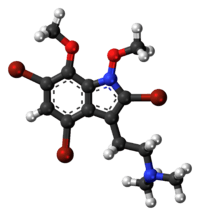Convolutindole A
 | |
 | |
| Names | |
|---|---|
| IUPAC name
2,4,6-Tribromo-1,7-dimethoxy-N,N-dimethyltryptamine | |
| Identifiers | |
| 443356-86-3 | |
| 3D model (Jmol) | Interactive image |
| ChemSpider | 4481610 |
| PubChem | 5324072 |
| |
| |
| Properties | |
| C14H17Br3N2O2 | |
| Melting point | 61.5 to 62.5 °C (142.7 to 144.5 °F; 334.6 to 335.6 K) |
| Except where otherwise noted, data are given for materials in their standard state (at 25 °C [77 °F], 100 kPa). | |
| | |
| Infobox references | |
Convolutindole A (2,4,6-tribromo-1,7-dimethoxy-N,N-dimethyltryptamine) is a brominated tryptamine alkaloid that was first identified in 2001 in Amathia Convoluta, a marine bryozoan. Bryozoans are aquatic invertebrates that grow in colonies and may resemble coral.
Chemistry
Convolutamine A is the 2,4,6-tribromo-1,7-dimethoxy derivative of DMT, a hallucinogen that occurs naturally in many plants and animals. Convolutamine A is chemically related to 5-bromo-DMT - A similar molecule that also occurs in many marine invertebrates.
The researchers who discovered the chemical drew specific attention to the methoxy group at the indole 1-position (attached to the nitrogen atom in the pentagonal ring) as being an unknown occurrence in the marine world until recently. 1-methoxyindoles such as Lespedamine also occur in Legumes and the Brassicaceae, the plant family that cabbage and mustard belong to.
Biological activity
This chemical was tested for its ability to kill parasitic nematodes, It was found to be more effective than levamisole, a synthetic drug used to kill parasitic worms and to treat colon cancer.
References
- Narkowicz, C. K.; Blackman, A. J., (June 2001). Abstracts of Papers; 10th International Symposium on Marine Natural Products: Nago, Okinawa, Abstract OR1.
- Narkowicz, C. K.; Blackman, A. J.; Lacey, E.; Gill, J. H.; Heiland, K. (2002). "Convolutindole a and Convolutamine H, New Nematocidal Brominated Alkaloids from the Marine BryozoanAmathia convoluta". Journal of Natural Products. 65 (6): 938–941. doi:10.1021/np010574x. PMID 12088445.